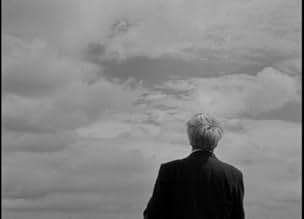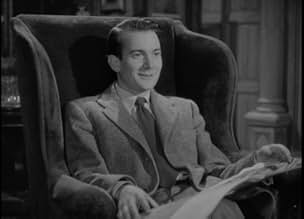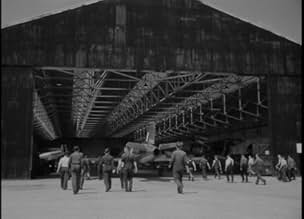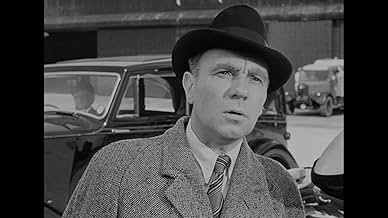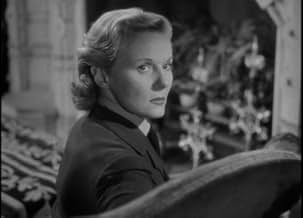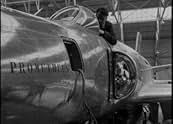VALUTAZIONE IMDb
6,7/10
2541
LA TUA VALUTAZIONE
Ingegneri aerospaziali britannici risolvono il problema del volo supersonico.Ingegneri aerospaziali britannici risolvono il problema del volo supersonico.Ingegneri aerospaziali britannici risolvono il problema del volo supersonico.
- Vincitore di 1 Oscar
- 9 vittorie e 5 candidature totali
Rodney Goodall
- Little Boy
- (non citato nei titoli originali)
Donald Harron
- ATA Officer
- (non citato nei titoli originali)
Vincent Holman
- Factor
- (non citato nei titoli originali)
Jolyon Jackley
- Susan's Baby
- (non citato nei titoli originali)
Douglas Muir
- Controller
- (non citato nei titoli originali)
Leslie Phillips
- Controller
- (non citato nei titoli originali)
Anthony Snell
- Peter Makepeace
- (non citato nei titoli originali)
Sally-Jane Spencer
- Daughter of Philip
- (non citato nei titoli originali)
Robert Brooks Turner
- Test Bed Operator
- (non citato nei titoli originali)
Recensioni in evidenza
This mid-period David Lean picture is one of his most unusual a drama woven out of a story of scientific exploration. Not an easy kind of picture to make, but one held together by Lean's refined direction, a great cast and a surprisingly good script by Terence Rattigan.
Although Lean was to make two small-scale pictures between this and Bridge on the River Kwai, this is perhaps more than any other a transition film between his early intimate dramas and the later massive epics he is now best known for. From the start Lean had always tried to photograph the psychological states of his characters, but The Sound Barrier is the first time he tells a bigger story through the personal experiences of individuals. This is the formula that has made Kwai and Lawrence of Arabia so popular and enduring. Like those later pictures, in the Sound Barrier the narrative switches to carry on the story through the eyes of other characters.
A story like this, concerning test pilots, engineering and scientific breakthroughs, will only work if there is a strong drama underlying it otherwise it's only going to be of interest to techies. Lean seems totally aware of this and emphasises the human story behind the science. He directs with his editor's eye, composing action sequences with series of still shots, then throwing in the occasional sharp camera move to punctuate an emotional moment. He is moving away a little from the rather obvious expressionistic techniques of his earliest films towards a more straightforward yet effective style.
By the early 50s the golden age of British film was over, but there was still a good crop of acting talent on offer, and there are plenty of names to mention in The Sound Barrier. Ralph Richardson plays (as he often did) the overbearing father-in-law, and lends the film a touch of class. Ann Todd, who was Lean's wife and not an exceptional actress, here gives what is probably her best performance she has the most difficult part in terms of emoting, but she carries it off brilliantly. This is also a great before-they-were-famous film, featuring a young Denholm Elliott (best known as Marcus Brody from the Indiana Jones films) and Leslie Phillips in his pre-Ding Dong days. The real acting treat here though is the rarely-seen John Justin, who failed to achieve stardom not through lack of talent, but through lack of interest on his part. His poignant final scene is one of the strongest in the whole picture.
Of course, it's not just the plot of The Sound Barrier that is a work of fiction the science is complete nonsense as well, so don't go thinking that pilots really reverse their controls to get through the sound barrier. In many ways, this film reminds me of Dive Bomber, made ten years earlier with Errol Flynn and Fred MacMurray. That's also a test pilot drama, with a fair few plot similarities. One major difference though is that whereas Dive Bomber deliberately and bluntly disposes of any romantic angle, writing the female characters out of the story halfway through, in The Sound Barrier it is the pressures on the wives and sisters that is pushed to the fore. Ultimately, it is the way The Sound Barrier deals with loss and guilt that make it a strong and satisfying film.
Although Lean was to make two small-scale pictures between this and Bridge on the River Kwai, this is perhaps more than any other a transition film between his early intimate dramas and the later massive epics he is now best known for. From the start Lean had always tried to photograph the psychological states of his characters, but The Sound Barrier is the first time he tells a bigger story through the personal experiences of individuals. This is the formula that has made Kwai and Lawrence of Arabia so popular and enduring. Like those later pictures, in the Sound Barrier the narrative switches to carry on the story through the eyes of other characters.
A story like this, concerning test pilots, engineering and scientific breakthroughs, will only work if there is a strong drama underlying it otherwise it's only going to be of interest to techies. Lean seems totally aware of this and emphasises the human story behind the science. He directs with his editor's eye, composing action sequences with series of still shots, then throwing in the occasional sharp camera move to punctuate an emotional moment. He is moving away a little from the rather obvious expressionistic techniques of his earliest films towards a more straightforward yet effective style.
By the early 50s the golden age of British film was over, but there was still a good crop of acting talent on offer, and there are plenty of names to mention in The Sound Barrier. Ralph Richardson plays (as he often did) the overbearing father-in-law, and lends the film a touch of class. Ann Todd, who was Lean's wife and not an exceptional actress, here gives what is probably her best performance she has the most difficult part in terms of emoting, but she carries it off brilliantly. This is also a great before-they-were-famous film, featuring a young Denholm Elliott (best known as Marcus Brody from the Indiana Jones films) and Leslie Phillips in his pre-Ding Dong days. The real acting treat here though is the rarely-seen John Justin, who failed to achieve stardom not through lack of talent, but through lack of interest on his part. His poignant final scene is one of the strongest in the whole picture.
Of course, it's not just the plot of The Sound Barrier that is a work of fiction the science is complete nonsense as well, so don't go thinking that pilots really reverse their controls to get through the sound barrier. In many ways, this film reminds me of Dive Bomber, made ten years earlier with Errol Flynn and Fred MacMurray. That's also a test pilot drama, with a fair few plot similarities. One major difference though is that whereas Dive Bomber deliberately and bluntly disposes of any romantic angle, writing the female characters out of the story halfway through, in The Sound Barrier it is the pressures on the wives and sisters that is pushed to the fore. Ultimately, it is the way The Sound Barrier deals with loss and guilt that make it a strong and satisfying film.
7sol-
British aviation enthusiasts seek to break the sound barrier by dangerously pushing their jets beyond their limits in this solidly crafted drama starring Ralph Richardson. The film has copped a lot of flak over the years for its historical inaccuracies (the Americans were actually the first to break the sound barrier with very different techniques), however, 'The Sound Barrier' works well as a character drama as long as one takes all the pseudoscience on hand with a pinch of salt. The movie is rather slow to warm up, focusing on a formulaic courtship between Richardson's daughter and an up and coming pilot, however, as soon as Richardson enters the scene, it becomes an experience that rarely lets up. It is quite a sight to see Richardson's boyish enthusiasm for the task at hand, waxing poetic about a "whole new world ... in the grasp of man", demonstrating how aerial flight works during dinner and proclaiming that "it's just got to be done". His character also comes with shades of ambiguity; is he at all guilt-ridden over the deaths of those trying to complete the quest or does he see the deaths as acceptable in the name of human progress? Richardson does very well adding such shades to his character and while none of the supporting players come close to equaling him, he is enough alone to carry the film, or at least when on-screen. The film is also blessed by some great spinning shots within mysterious clouds and as one might expect from a film with such a title, the Oscar winning sound mixing here is highly effective.
This black and white early 50s movie shows crusty Britain at its stiff upper lip best. It is the story of mans obsession with speed, and a ruthless plane makers ambition to succeed in building a supersonic jet. Richardson plays the tycoon whose dream kills his son and son-in-law, but who finally sees the error of his ways and whose daughter returns to the cold family home with his grandson.
The film is also a vehicle to show the world Britain's proud lead in jet technology. There is a classic sequence in the film where the happy daughter and son-in-law deliver a De Havilland Vampire jet fighter to Egypt. They set off at breakfast time in England and hurtle over the English Channel, the Alps, Ancient Greece and the Pyramids before arriving in at the airfield. Of course we take this for granted now, but 47 years ago this was unheard of. The director contrasts the old ruins and remains of our ancient ancestors with the marvel of the modern age: the jet plane.
The film also introduced THE marvel of the early fifties, the De Havilland Comet jet liner. This beautiful but flawed machine was in service SIX years before any other jet liner and for a while, the world rushed to De Havillands, and Britains door. For two years the worldwide fleet gave the travelling of the future.
In every other way this is an eccentrically English film with creaky old houses, cottages with roses around the door and eccentric engineers. Shout in glorious black and white it conveys a sense of wonder and optimism in the future, whilst being thoroughly old fashioned
The film is also a vehicle to show the world Britain's proud lead in jet technology. There is a classic sequence in the film where the happy daughter and son-in-law deliver a De Havilland Vampire jet fighter to Egypt. They set off at breakfast time in England and hurtle over the English Channel, the Alps, Ancient Greece and the Pyramids before arriving in at the airfield. Of course we take this for granted now, but 47 years ago this was unheard of. The director contrasts the old ruins and remains of our ancient ancestors with the marvel of the modern age: the jet plane.
The film also introduced THE marvel of the early fifties, the De Havilland Comet jet liner. This beautiful but flawed machine was in service SIX years before any other jet liner and for a while, the world rushed to De Havillands, and Britains door. For two years the worldwide fleet gave the travelling of the future.
In every other way this is an eccentrically English film with creaky old houses, cottages with roses around the door and eccentric engineers. Shout in glorious black and white it conveys a sense of wonder and optimism in the future, whilst being thoroughly old fashioned
This is an outstanding film about the human cost of progress and obsession. Richardson is great as the aviation mogul willing to pay the necessary price for reaching new realms and new worlds. Historically and technically, the film is so out in left field as to be almost laughable (the plot point about control reversal is apparently the result of a writer hearing a valid aeronautical term and misunderstanding it completely) but in the end, the issues raised and the fine performances make Sound Barrier a winner. The aerial photography is outstanding, and there is one beautifully composed shot from below the nose of the Comet airliner that perfectly emphasizes the sleek lines of that most beautiful jet.
The opening of the film, when a World War II fighter pilot hit what used to be called "compressibility," was a suspenseful interlude for the audience, particularly since it wasn't explained at the time.
The film was shot in monochrome, and was produced during a time that technology was accelerating, and this was one of the early films outside some of the science-fiction films of the era that was pro-technology. It is interesting that most of the major characters were obsessed with pushing the envelope.
As has been mentioned elsewhere, the "solution" presented to maintaining control of a supersonic aircraft actually is inaccurate. When a reporter asked the person who first actually broke the sound barrier, Gen. Chuck Yaeger, about that "solution," he indicated that doing what was proposed would have ensured the death of the pilot.
The film is well worth watching, if for no other reason than to get a taste of people taking baby steps in the new world of postwar technology.
The film was shot in monochrome, and was produced during a time that technology was accelerating, and this was one of the early films outside some of the science-fiction films of the era that was pro-technology. It is interesting that most of the major characters were obsessed with pushing the envelope.
As has been mentioned elsewhere, the "solution" presented to maintaining control of a supersonic aircraft actually is inaccurate. When a reporter asked the person who first actually broke the sound barrier, Gen. Chuck Yaeger, about that "solution," he indicated that doing what was proposed would have ensured the death of the pilot.
The film is well worth watching, if for no other reason than to get a taste of people taking baby steps in the new world of postwar technology.
Lo sapevi?
- QuizThe flying sequences under the direction of Anthony Squire, were based at the Vickers aerodrome at Chilbolton near Nether Wallop in Hampshire. Squire managed to secure one of the last airworthy Avro Lancaster bombers for the task. The cameramen were positioned in the front and rear turrets while Squire conducted proceedings from the central astrodome. The Lancaster was replaced by a Vickers Valetta after all the crew except Squire fell asleep due to an oxygen supply failure. Luckily as he recalled, "They all woke up on the way down, like people in a fairy wood, but I didn't bother with the Lancaster again."
- BlooperAfter he and his wife alight from a Comet airliner, Garthwaite is seen reading that evening's newspaper, dated Saturday, 28 September 1946. The Comet didn't make its maiden flight until July 1949 and didn't enter service until 1952.
- Citazioni
Susan Garthwaite: [regarding an image of the surface of the moon, displayed via JR's telescope] What's that?
John Ridgefield: It's the moon.
Susan Garthwaite: I never knew it could look so unfriendly.
John Ridgefield: It's an unfriendly universe.
Susan Garthwaite: Do you believe that?
John Ridgefield: Unfriendly only because it's unconscious of our existence.
- Curiosità sui creditiIn the opening credits, immediately after the human actors, are listed four British aircraft: The de Havilland COMET The Vickers-Supermarine ATTACKER The de Havilland VAMPIRE 113 The Vickers-Supermarine SWIFT Rolls-Royce 'Avon' Engine
- ConnessioniFeatured in Jet! When Britain Ruled the Skies: Military Marvels (2012)
- Colonne sonoreWith Sword and Lance
(uncredited)
Music by Hermann Starke
I più visti
Accedi per valutare e creare un elenco di titoli salvati per ottenere consigli personalizzati
- How long is The Sound Barrier?Powered by Alexa
Dettagli
- Data di uscita
- Paese di origine
- Lingua
- Celebre anche come
- Breaking the Sound Barrier
- Luoghi delle riprese
- Chilbolton Aerodrome, Nether Wallop, Hampshire, Inghilterra, Regno Unito(flying sequences)
- Aziende produttrici
- Vedi altri crediti dell’azienda su IMDbPro
Botteghino
- Budget
- 250.000 £ (previsto)
- Tempo di esecuzione
- 1h 58min(118 min)
- Colore
- Proporzioni
- 1.37 : 1
Contribuisci a questa pagina
Suggerisci una modifica o aggiungi i contenuti mancanti


